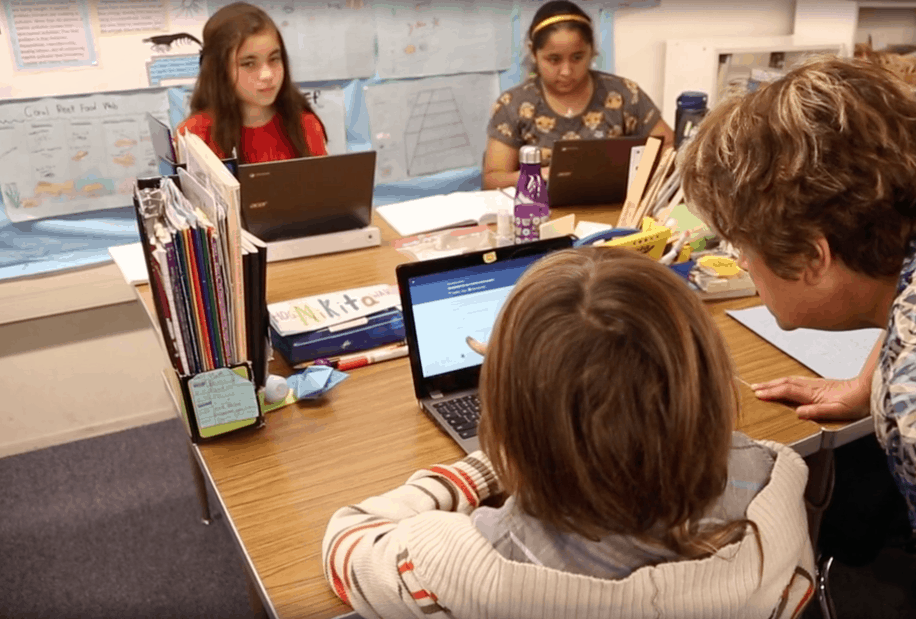The Best Impact Story in Education Keeps Getting Better

Curriculum Associates is the best edtech success story in America, in several ways. Eleven years ago, Rob Waldron took the helm of a small New England workbook publisher and turned it into a digital learning leader. The flagship adaptive instructional product, i-Ready, is now serving 7 million students and educators and recently provided its billionth lesson.
In 2017, the company made a historic charitable gift, giving away the majority of its shares, which created a $145 million endowment at Iowa State University and a $50 million donation to the Boston Foundation.
I recently spoke with Waldron about these impressive milestones and how he sees the education landscape changing in the coming years.
TVA: A decade ago, you took over a sleepy workbook publisher. What made you think you could build it into the biggest impact engine of the decade?
RW: To be honest, the focus in my first couple of years was far less lofty. We were in a recession, and I was deeply focused on the challenge of “Can I maintain a company that serves teachers and kids well…but that doesn’t go bankrupt?”
We were operating in a context of 10 percent unemployment locally, and our staff was mostly over the age of 40 doing editorial work. I knew that downsizing would mean these dedicated folks wouldn’t have had many options for where to turn.
TVA: And add to that, the end of the Great Recession also looked like the end of traditional publishing to many.
RW: Exactly. Other big publishers were shedding people profusely, and I was spending most of my energy trying to keep our doors open. Schools didn’t have money at the time, so we focused on partnering closely with them, offering exceptional services and high quality resources at an affordable price. While others in the industry dealt with the downturn by figuring out ways to downsize or putting new labels on old programs to scrape by, we built strong relationships with educators by putting people first and responding to their needs.
TVA: How did you build a team to develop the leading adaptive learning engine i-Ready? How did they do it so fast?
RW: When I first came to the company, we licensed an adaptive assessment product from a third party. While the science was good, there were a bunch of technical issues and we kept finding that our customers weren’t getting the service they needed. When we cut off that relationship, we had the opportunity to build something ourselves to replace it.
The process was challenging, but our timing was just right. With the recent release of Common Core, educators were looking for an adaptive tool to support student learning of more rigorous standards. Because of our deep focus on service and commitment to transparency, people trusted that we would provide strong support and continue to improve the tool to best serve their students. While bootstrapping i-Ready, we also fixed the book business and launched Ready, a blended approach (both paper and digital). We don’t care whether it’s digital or print; the key is what solution is needed by the educator.
In retrospect, the fact that we created these tools without outside capital and were forced to make every decision on our own dime was a huge contributor to the initial success of i-Ready. It enabled us to be deeply attuned to the needs of educators, and thoughtful about the long-term viability of the solutions we were creating. This future-focused lens continues to be a competitive advantage for us.
TVA: Curriculum Associates quickly became a leader in software-as-a-service. Because it was a new business model in education, we wrote a paper together: Smart Series Guide to EdTech Procurement. i-Ready is a great product, but it seems to be service that is your big differentiator. Five years ago when we wrote that paper, you said it was support services that were the difference between efficacy and inactivity. Is that still true?
RW: Great service begets a great product; Over 40 percent of our employees actually do service full-time—everything from monitoring usage reports, providing professional development, meeting with district leadership, onsite tech support, etc. Schools are complicated institutions to run, so our job is to ensure the industry’s top talent is serving these educators and that we are efficient at providing this high level of service across environments.
TVA: i-Ready just hit a billion lessons, Curriculum Associates recently had its 50th anniversary, and you recently celebrated your first decade as CEO. These are big milestones—what have been the biggest changes in the last decade?
RW: The way the world used to work, a study of learning could look like a couple graduate researchers reviewing data from 80 students to prove a hypothesis. Today, we have incredibly robust data to inform our program design and make the right choices for students. If, for example, we delivered a lesson on a given subject 15,000 times and only 2,000 students reached mastery, we know there’s something we need to fix…and we do!
You need incredible nuance into the details of lesson design to make the best possible product. By addressing all the “micro-levers,” which could include the minute mark in a lesson when students stop being engaged or a window that takes a half second too long to open, we ensure our tools are as engaging as possible to learners and as supportive as possible to the educators we serve.
Another success factor has been our investment in constant improvement. A few years ago we spent $50 million on R&D in product and tech, and this year we’re spending nearly double as we focus on making current grades and content better. We’re continually rolling out many major releases—last year alone delivering over 60 improvements to i-Ready—and it’s only accelerating.
TVA: And have you done any recent studies on the impact of your programs on student learning?
RW: We’ve released several. Most recently, new third party research conducted by HumRRo showed that our Ready Mathematics blended solution meets ESSA evidence requirements and supports student gains. We’re committed to continued research to guide our improvement efforts and deliver the best possible tools to support learning.
TVA: Five years ago, you said hiring was key to your successful scaling, is that still the case?
RW: Yes. In my experience, an organization is only as strong as the talent that drives it. It is so critical that we have the right people on board, aligned with our values and committed to service, that recruiting continues to be among the most important uses of my time. I still interview every final round candidate…no small feat as we continue to grow! Last year, that meant 337 interviews. We are extremely selective, only hiring 1 in 30 who apply, and 1 in 8 who interview.
As a result, our employees are incredibly dedicated to our shared mission. As reported in our most recent anonymous employee survey, 96 percent of people who work for us would recommend their best friends work for us. To me, that’s the best measure of getting it right.
TVA: How have efforts to support equity played into your strategy development, and where do you see the biggest opportunities moving forward?
RW: For starters, I like to ground us in the idea that there’s no such thing as a typical student. We believe all students bring unique assets to their learning environments, and we work to ensure our tools leverage these and are accessible by and representative of the diverse populations we serve. We keep in mind, for example, ways in which the decisions we make could impact English learners and students of different socioeconomic backgrounds. We’re introducing a Spanish diagnostic in the near future, and are making accessibility a much bigger focus in general.
Overall, we’ve found that adaptive tech is uniquely poised to serve all learners. For example, one thing we often see is that some students with special needs might be off the charts in one subject and struggle in another, and adaptive software can pinpoint those nuances and provide teachers with precise information about that student to drive the most effective instructional decisions.
TVA: The Curriculum Associates goal, as you’ve described it, “is to make educators more productive…by making simple-to-use products that save teachers and administrators time, all while increasing student achievement.” Does that still describe the role you see tech playing in schools?
RW: We’ve all had that experience of the person in our lives that made us believe in ourselves and made that lifelong difference. i-Ready will never be that—we’ll always be subordinate to the teacher and their need. We designed i-Ready as a system to support teachers. When I think of all the unbelievable things tech can do, I’m well aware of the need of one human being to be with another to build trust and relationships. We don’t intend to be that. Our job is to make it much easier for teachers to do their jobs.
My mother was a single mom and teacher, so I’ve seen firsthand how hard that life is. We value saving teachers time and helping them be more productive as a huge part of our work.
TVA: How does i-Ready use data? We’re very interested in interoperability, and data security has been another hot topic recently.
RW: Schools own all i-Ready data; we just keep it as secure as humanly possible. We go through all sorts of rigorous processes including fishing exercises and training for every employee to avoid third-party attacks. After that, we make sure schools own the data.
We also work with Ed-Fi and Clever as schools request. We support integration with those organizations well, but it’s the school’s decision.
TVA: What about data that is specific to learning experiences?
RW: We’re very interested in Dweck’s work around growth mindset and Duckworth’s notion of the importance of grit. When we look at how children work, we ask ourselves: “Are they going for the more difficult option? Are they challenging themselves?” By focusing on the choices students are making, we can actually report on grit to teachers.
TVA: One design flaw that we see more often than we would like in schools is that tech is sometimes used for over-assessment. How can schools use a tool like i-Ready while avoiding that trap?
RW: I agree that that is a problem. One thing that’s so great about adaptive tools is that you can actually have fewer questions and assessments due to the efficiency of the learning process. Students with tailored assessment and instruction save a lot of time.
TVA: We hear you’re planning some updates to i-Ready in the near future. What’s coming down the pipeline?
RW: In addition to the accessibility and Spanish diagnostic additions that I mentioned earlier, we’ve got a number of other things coming up, including 100 new lessons for middle school students and a core math product for grades K-5 and 6-8. We’re also working to change the student experience with i-Ready to give them more agency, historical reporting, and diagnostic information, and to build new school- and district-level reports.
For more, see:
- 5 Lessons on Impact Leadership (2016 podcast with Rob Waldron)
- 3 Lessons from Curriculum Associates’ Explosive Growth (feature by Michael Horn)
- EdTech Acquisition Will Enhance Engagement and Strengthen Conceptual Understanding in Math (CA acquired Motion Math)
- Curriculum Associates: Blended Success Story (2017 feature)
- Curriculum Associates: For-Impact Enterprise (2016 feature)
This post was originally published on Forbes.







0 Comments
Leave a Comment
Your email address will not be published. All fields are required.